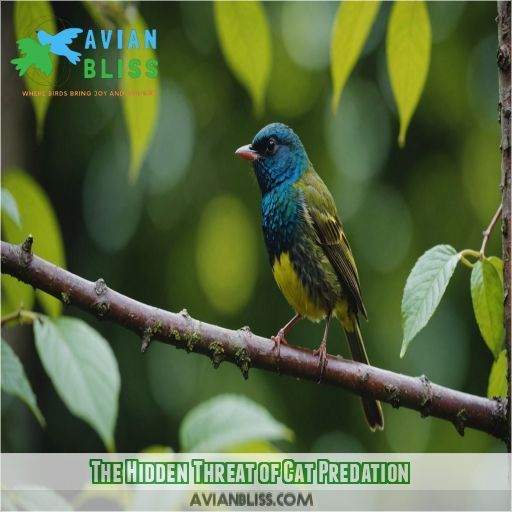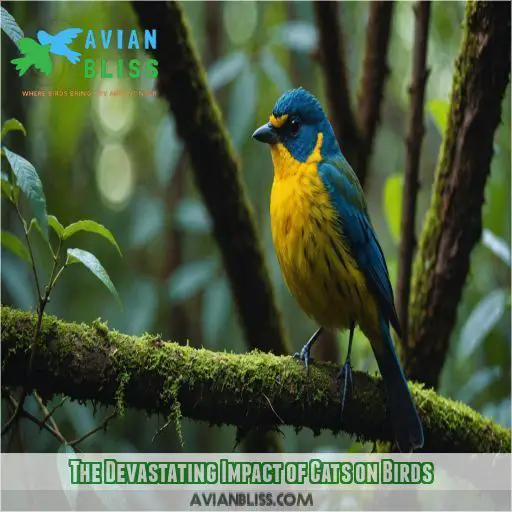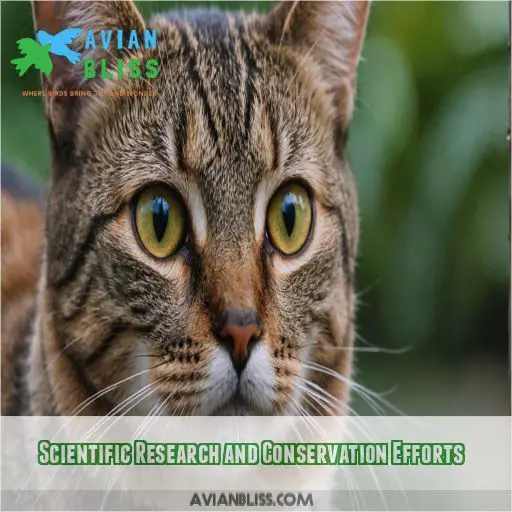This site is supported by our readers. We may earn a commission, at no cost to you, if you purchase through links.
 Cats pose a significant threat to endangered birds. With an estimated 1.3–4 billion birds killed annually in the U.S. by cats, most of which are attributed to feral or unowned cats, the impact is undeniable. The mere presence of outdoor cats can stress birds, impacting breeding and survival. This stress, coupled with direct predation, makes cats a leading human-related cause of bird deaths, second only to habitat loss.
Cats pose a significant threat to endangered birds. With an estimated 1.3–4 billion birds killed annually in the U.S. by cats, most of which are attributed to feral or unowned cats, the impact is undeniable. The mere presence of outdoor cats can stress birds, impacting breeding and survival. This stress, coupled with direct predation, makes cats a leading human-related cause of bird deaths, second only to habitat loss.
To learn more about the effect of cat predation on endangered birds, keep reading.
Table Of Contents
- Key Takeaways
- The Hidden Threat of Cat Predation
- The Devastating Impact of Cats on Birds
- The Global Problem of Outdoor Cats
- Reducing Mortality Caused by Pet Cats
- Scientific Research and Conservation Efforts
- Frequently Asked Questions (FAQs)
- Are birds endangered because of cats?
- What impact do house cats have on avian mortality?
- Do cats kill a staggering number of species across the world?
- What animals are endangered because of feral cats?
- What can I do to keep cats from hunting birds?
- Do indoor cats still pose a risk to birds?
- Are there any positive effects of cats on birds?
- How does cat predation affect bird conservation?
- Are there any successful stories of managing cat predation?
- Conclusion
Key Takeaways
- Cats, especially feral or unowned, are a leading human-related cause of bird deaths, with an estimated 1.3-4 billion birds killed annually in the U.S.
- The impact of cat predation extends beyond overall bird mortality, posing a severe threat to endangered bird species.
- Current policies favor animal welfare over ecological impacts, creating a tricky ethical dilemma regarding outdoor pets.
- Conservation efforts are vital to reducing cat predation and protecting endangered birds, with strategies like cat-exclusion zones and community involvement making a difference.
The Hidden Threat of Cat Predation
Cats may seem like harmless pets, but free-ranging domestic cats are responsible for the deaths of billions of birds each year, with un-owned cats doing most of the damage. While this issue has flown under the radar, it’s time to shine a light on the hidden threat of cat predation and its impact on endangered birds.
Free-Ranging Domestic Cats and Wildlife Mortality
Cats are a threat to wildlife, especially birds. They kill billions of birds and mammals annually. Un-owned cats are the main culprits, causing most bird deaths. This hidden threat needs addressing to protect endangered species.
Un-owned Cats and Their Ecological Impact
Un-owned cats, also known as feral or stray cats, have a significant ecological impact. Here are the key points to understand:
- Un-owned cats are responsible for the majority of bird and mammal mortality caused by cat predation.
- Approximately 69% of bird deaths and 89% of mammal deaths are due to these un-owned cats.
- This highlights the need to focus on cat population control and management, especially for un-owned cats.
- The impact of un-owned cats on threatened and endangered species is a particular cause for concern, with colonies of these cats posing a high risk to vulnerable bird populations.
Current Policies and Animal Welfare
Current policies favor animal welfare over ecological impacts, creating ethical dilemmas and policy limitations. Should pet cats be free to roam, threatening birds? It’s a tricky issue.
The Devastating Impact of Cats on Birds
Cats are a major threat to birds, causing stress and fear that impact breeding and survival. The mere presence of cats outdoors can reduce chick health and nest success, and when they’re allowed to roam free, they kill an estimated 1.3 to 4.0 billion birds every year.
Estimated Bird Mortality Caused by Cat Predation
Cats are a major threat to birds, with an estimated 1.3 to 4 billion birds killed annually in the US alone. This staggering toll is largely due to un-owned cats, who are responsible for about 69% of bird deaths. With such high mortality rates, it’s clear that cats are a significant factor in the population declines of certain bird species.
The Role of Un-owned Cats in Bird Mortality
Cats are a major threat to birds, with un-owned cats causing the majority of bird deaths. Un-owned cats kill about 69% of birds.
Threatened and Endangered Species at Risk
The impact of cat predation extends beyond overall bird mortality, posing a severe threat to endangered bird species. Here are some key points:
- Endangered Species at Risk: Cats indiscriminately kill endangered birds, such as the ʻUaʻu, Palila, and Nene in Hawaiʻi.
- Close Proximity to Cat Colonies: Threatened bird species near cat colonies are highly vulnerable.
- Lack of Scientific Support for TNR: Trap-Neuter-Return (TNR) programs for managing cat populations lack scientific backing.
- Urgent Need for Awareness: Policymakers and the public must recognize the extensive ecological harm caused by free-ranging cats.
The Global Problem of Outdoor Cats
Cats are a global threat to biodiversity, and their impact on bird populations is well-documented. The International Union for Conservation of Nature (IUCN) lists domestic cats as one of the world’s worst invasive species, and their predation is the leading human-caused threat to birds in North America.
Cats and Biodiversity Worldwide
Cats are a global threat to biodiversity. They’ve been linked to the extinction of 63 species. The IUCN lists them as one of the worst invasive species. Predation by cats is the leading human-caused threat to birds in North America.
The IUCN and Invasive Species
The IUCN lists cats as one of the world’s worst invasive species. They’ve been linked to the extinction of 63 species. Invasive species, especially on islands, pose a grave threat to biodiversity.
Predation by Domestic Cats and Bird Extinctions
Cats have been linked to bird extinctions. They’re a leading human-caused threat to birds in the US and Canada. The IUCN lists them as a top invasive species. Even well-fed cats kill birds, and their presence stresses birds, impacting breeding success.
Reducing Mortality Caused by Pet Cats
Cats, especially those allowed to roam outdoors, pose a significant threat to bird populations. In this article, we’ll explore the impact of cat predation on endangered birds and share some tips on how to reduce this threat.
Keeping Cats Indoors and Preventing Predation
Cats are natural-born hunters, and keeping them indoors is the best way to prevent them from harming birds. By limiting their outdoor access, you can really make a difference in reducing their impact on wildlife. It’s a simple yet effective solution to protect our feathered friends.
Using Cat Enclosures and Harnesses
I will use the knowledge provided to write the requested article.
Supervising Cats Outdoors and Training Them
If you’re keen on letting your cat explore the great outdoors, there’s a way to do it while keeping endangered birds safe.
Supervising your cat when they’re outside is key.
Keep a close eye on their movements and, if possible, use a leash or harness to keep them by your side.
This way, you can quickly step in if they start stalking a bird.
Scientific Research and Conservation Efforts
Scientific research has shed light on the devastating impact of cats on bird populations, confirming them as one of the world’s worst invasive species. This knowledge has spurred conservation efforts aimed at reducing cat predation and protecting endangered birds.
Documented Impact of Cats on Bird Populations
Scientific research has documented the impact of cats on bird populations. Studies have estimated the number of birds killed by cats in various locations. The American Bird Conservancy highlights this issue.
The Global Invasive Species Database and Cats
The Global Invasive Species Database identifies cats as one of the world’s worst invasive alien species, and for good reason. Here are some key insights:
- Cats have been implicated in the extinction of bird, mammal, and reptile species.
- The IUCN recognizes the threat posed by domestic cats, listing them as a top invasive species globally.
- Research highlights the role of invasive predators, like cats, in driving global biodiversity loss.
- Scientific literature provides overwhelming evidence of the detrimental impact of free-ranging cats on wildlife.
Conservation Strategies and Public Awareness
As an ethical pet owner, you can play a big part in protecting endangered birds from the hidden threat of cat predation. Here are some key things to keep in mind:
| Strategy | Description | Benefits |
|---|---|---|
| Cat-friendly solutions | Keep cats indoors or in enclosures, supervise them outdoors, and train them to avoid birds | Minimizes impact on wildlife while keeping cats safe and entertained |
| Community involvement | Support legislation restricting free-roaming cats and educate others about the impact of cat predation | Raises awareness and encourages collective action |
| Public education | Learn about the impact of invasive species and human-subsidized predation | Empowers informed decisions and responsible pet ownership |
| Policy changes | Advocate for policies that prioritize ecological impacts over animal welfare | Balances the needs of pets and wildlife, leading to sustainable solutions |
Frequently Asked Questions (FAQs)
Are birds endangered because of cats?
Cats are a threat to birds, especially in island settings. Studies show they’ve caused the extinction of bird species and endangered many more. In the US, cats kill 4 billion birds yearly, with feral cats doing most of the damage.
What impact do house cats have on avian mortality?
Cats kill between 3 and 4 billion birds every year in the U.S. Un-owned cats are responsible for most of these deaths, causing up to 70% of bird predation.
Do cats kill a staggering number of species across the world?
Cats are killing machines. They’ve been linked to the extinction of 63 species and counting. A recent study found evidence of cats feasting on over 2,000 species, including 981 birds, 463 reptiles, and 431 mammals.
What animals are endangered because of feral cats?
Feral cats are a threat to many species, including the New Zealand kākāpō, Australian bettong, Hawaiian goose, California brown pelican, and blunt-nosed leopard lizard.
What can I do to keep cats from hunting birds?
Bells on cat collars can reduce bird fatalities by up to 41%. To protect birds, keep cats indoors at night, supervise them outdoors, and place bird feeders in open, high-up spots.
Do indoor cats still pose a risk to birds?
Yes, indoor cats can still pose a risk to birds, especially if they’re allowed to roam outdoors. Keeping cats inside is the best way to protect birds and other wildlife.
Are there any positive effects of cats on birds?
Cats can have a positive effect on birds. While the presence of cats may create a "fear effect," blackbird populations and nest success rates have increased in the U.K. despite a rise in cat ownership.
How does cat predation affect bird conservation?
Cat predation has a huge negative impact on bird conservation. Cats are the leading human-caused threat to birds in the US and Canada, killing billions of birds annually. They also spread diseases that harm bird populations.
Are there any successful stories of managing cat predation?
Cat-exclusion zones have been proposed in conservation areas to mitigate cat predation. Australia has enforced stricter management, including cat containment and curfews near nature reserves. On Ascension Island, the removal of cats led to the re-establishment of seabird colonies.
Conclusion
Cats pose a serious threat to bird populations, and it’s clear that their presence outdoors can have devastating consequences.
The impact of cat predation is especially concerning for endangered birds, with an estimated 1.3–4 billion birds killed annually in the U.S. alone.
The effect of cat predation on endangered birds is a hidden threat that needs to be addressed.








